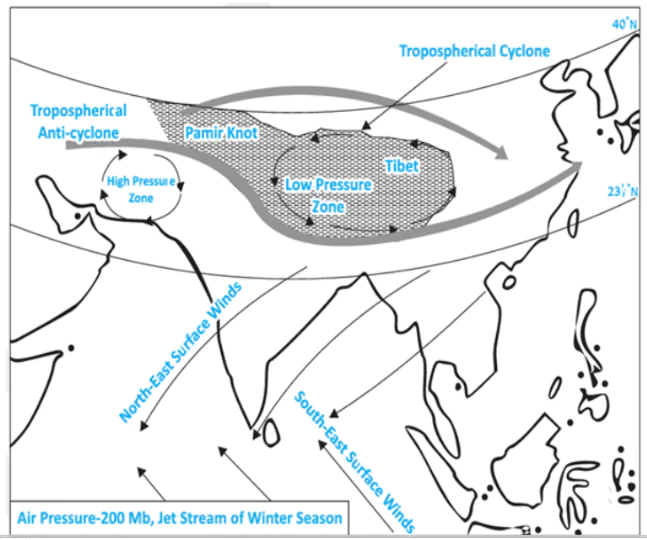In northern India, the cold weather season starts around mid-November and lasts till February, with December and January being the coldest months. Temperatures drop from south to north, with Chennai averaging around 24°–25°C and northern plains ranging from 10°C to 15°C. This period sees warm days and cold nights, with frost in the north and snowfall in the Himalayas.
An Overview of Weather Conditions in the Winter Season
A. Surface Pressure and Winds
- Influence By: Weather conditions are generally influenced by the distribution of pressure in Central and Western Asia.
- During winters a high pressure zone develops over Central Asia.
- The surface winds blowing out of that region reach India in the form of dry continental air mass that comes in contact with trade winds over northwestern India.
- North Westerly Winds: The contact zone is not stable and sometimes it shifts up to the middle Ganga valley, thus bringing the entire North-western India the influence of the North-Westerly winds.
- Feeble High-pressure: conditions prevail over the northern plain; air pressure is slightly lower in South India.
- Winds start blowing from the northwestern high pressure zone to the low air pressure zone over the Indian Ocean in the south.
- Directions: Westerly or northwesterly down the Ganga Valley; Northerly in the Ganga-Brahmaputra delta; Northeasterly over Bay of Bengal due to absence of influence of topography.
Enroll now for UPSC Online Course

B. Role of Jet Stream and Upper Air Circulation
- During winters the SubTropical Westerly Jet Streams flowing across the Asian continent gets bifurcated at the Tibetan Himalayas. Branches:
- Northern Branch: blows north of the Tibetan highlands
- Southern Branch: blows in an eastward direction, south of the Himalayas.
- The Southern Branch has a significant influence on the winter weather.
C. Role of Western Cyclonic Disturbance and Tropical Cyclones
- Indicator of Cyclone Disturbances: An increase in the prevailing night temperature generally indicates an advance in the arrival of these cyclone disturbances.
- Origin: The western cyclonic disturbances originate over the Mediterranean Sea and are brought into India by the westerly jet stream.
- They pick up the moisture from the Caspian Sea in the north and the Persian Gulf in the south and cause winter rainfall in North west India.
- Mahawat: Although the total amount of winter rainfall locally known as ‘mahawat’ is small, they are of immense importance for the cultivation of ‘rabi’ crops.
- Tropical Cyclones: develop in the Bay of Bengal during the late summer season.
- These cyclones are pushed towards India’s eastern coast by North East monsoon winds causing rain.
- They hit the Tamil Nadu, Andhra Pradesh and Odisha coast.
- Tamil Nadu coast experiences rain during winter.
- Winter in northern India can be very cold, with temperatures sometimes dropping below freezing. This cold is attributed to three reasons:
- Continentality: States like Punjab, Haryana, and Rajasthan are far away from the moderating influence of sea and experience continental climate.
- Snowfall: in the Himalayan ranges creates a cold wave situation;
- Cold Waves: Around February, the cold winds coming from the Caspian Sea and Turkmenistan bring cold waves along with frost and fog over the north-western parts of India.
- In contrast, the Peninsular region does not have any well-defined cold weather season due to the moderating influence of the sea and its equatorial proximity.
|
- Rainfall: Winter monsoons do not cause rainfall (move from land to the sea) because of little humidity and due to anticyclonic circulation on land. Some exceptions-
- In northwestern India, some weak temperate cyclones from the Mediterranean Sea cause rainfall in Punjab, Haryana, Delhi and western Uttar Pradesh.
- It is in the form of snowfall in the lower Himalayas.
- Precipitation decreases from west to east in the plains and from north to south in the mountains.
- Central parts and northern parts of the southern Peninsula occasionally get winter rainfall.
- Arunachal Pradesh and Assam in the northeastern parts (meagre amount).
- Northeast Monsoon: during October and November crosses over Bay of Bengal, picks up moisture and causes rainfall over the Tamil Nadu coast, southern Andhra Pradesh, southeast Karnataka and southeast Kerala.
Enroll now for UPSC Online Classes
Conclusion
During the cold weather season, northeast trade winds prevail over India, bringing dry weather across most regions. Cyclonic disturbances from the west and northwest contribute to winter rains in the northern plains and snowfall in mountainous areas, crucial for ‘rabi’ crop cultivation. While the peninsular region experiences less defined cold weather due to the moderating influence of the sea, the season brings distinct temperature variations across the country.
![]() May 4, 2024
May 4, 2024
![]() 7253
7253
![]() 0
0
